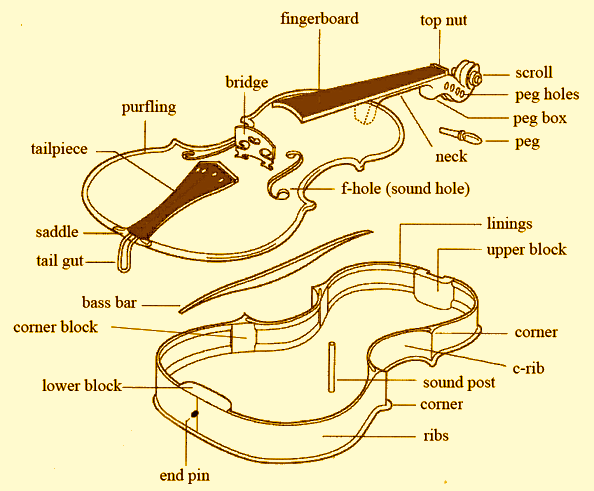| PHYSICS OF VIOLINS | Home |
Brief History |
Violin Body |
Violin Strings |
Chaconne |
Bibliography |

Photo: Property of Carie Navio
|
~VIOLIN~BODY~
The body of the violin is created from wood, primarily spruce and maple. Spruce is used for the soundboard because it is light but longitudinally strong as well as laterally flexible. It’s most prominent feature is vertical graining. Maple is a popular wood for the back of the violin. The inner workings -- bass bar and soundpost -- are created from spruce. The fittings are made from dense hardwood: ebony, rosewood, or boxwood. The modern fingerboard is made from solid ebony whereas the old violins used lighter hardwoods like poplar and would cover them with maple, ebony, or dyed wood veneer, since exotic hardwoods were in short supply. There are a number of reasons as to why one would choose a specific wood over another, but when creating a violin, wood is not simply cut then glued together. According to gussetviolins.com, violin makers prefer wood grown at higher altitudes on northern slopes. Wood is cut during the cold months and seasoned (stored) in controlled conditions for several years. Even after all of this newfound technology, scientists continue to research and analyse violins made by Stradivari and Guarneri because there still seems to be a mystery on how these instruments have better sound quality than new violins made. In 2008, an article was published discussing how a CT scanner was able to build a picture of a violin’s density vibrations. The research found that the overall density of the two groups (five antiques by Stradivari and Guarneri versus seven modern-day instruments) was about the same, but the plates of the older instruments had much more uniform density, versus the new instruments. The homogenous density of old violins makes them stiffer and gives them more sound-damping characteristics, producing greater sound quality. All parts of the violins body; front plate, back plate, sides, as well as the air inside, serve to transmit the vibration from the strings to the air around the instrument. If you watch a violinist play, you can notice how the violin is held only on the fingerboard while the shoulder rest (used typically although some people opt out of it) prevents the player’s shoulder to directly touch the back of the instrument. The belly and back plates are made to vibrate up and down at different frequencies. The violin is being held at opposite sides of the violins body and the vibration created can be described as Chladni patterns. Studies on Chladni patterns on the violin have given violin makers and scientists a better understanding of how the plates should be processed in terms of scraping when creating the final body shape. |
 Source Scroll - This is
located at the top of the violin. It is a
decorative part, mostly hand carved.
Pegbox - This is where the pegs are inserted. The pegs are adjusted to tune the violin. Nut - Helps keep the distance of the strings and supports the strings so that it has a good height from the fingerboard. Strings - It has 4 strings that are tuned a fifth apart. Bridge - The position of the bridge is essential as it directly relates to the quality of sound produced by the violin. The bridge is held in place by the strings' tension. When the string vibrates, the bridge also vibrates. Fingerboard - It is a strip of wood on the neck of the violin where the strings are. When a violinist plays, he presses down the strings on the fingerboard, thus changing the pitch. Sounding Post - Located under the bridge, it supports the pressure inside the violin. The bridge and sounding post are directly related, when the violin vibrates, the bridge, body and sounding post vibrates as well. F Holes - Is located in the middle of the violin. It is called F Hole because it is shaped like an F in Italics. It allows sound to come out of the violin. Altering the F Hole, such as its length, can affect the sound of the violin. Tailpiece - Holds the strings so that it has a good distance from the bridge. Chin Rest - It helps the violinist hold the instrument in place. While playing, the violinist can use his chin to hold the violin, thus freeing up his hands. |
| Examples of Chladni Patterns
on Violins "The (two) photographs below show the lowest frequency mode for a violin back [mode 1], a uniform rectangular plate [mode (1,1)]." - Source Source |
|